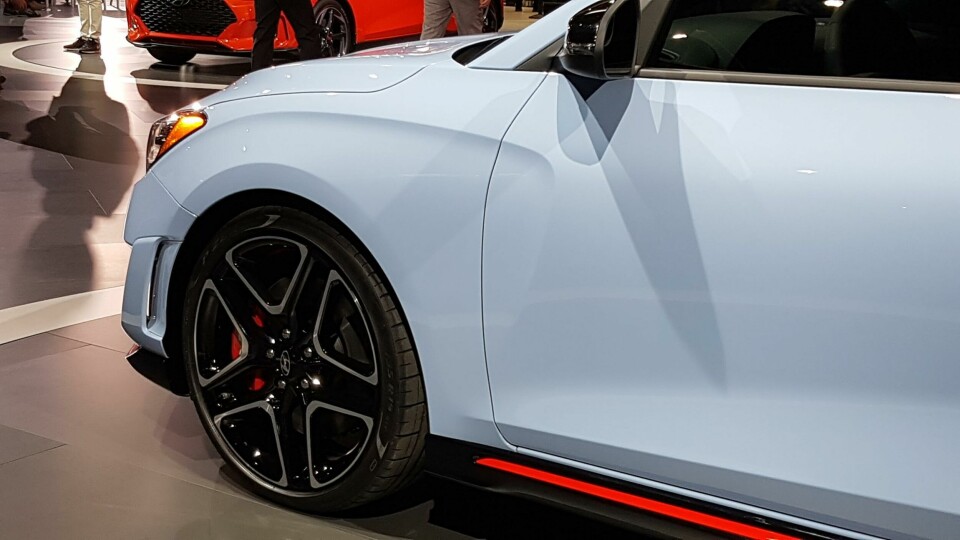
Detroit 2018: Hyundai Veloster Returns with More ‘N’
Peculiar asymmetrical hatch-coupé mashup debuts in Detroit
The Hyundai Veloster (apparently a portmanteau of Velocity and Roadster) was always a strange car to exist. First seen in 2011, when three-door hatchbacks were increasingly trying to convince you they were coupés, the thing that stopped it merely being a Korean take on the VW Scirocco of the time was its asymmetrical door layout.

Original Veloster (image from a Forza promotional video)
It sported two doors on the kerb side for practicality, but just one on the driver’s side to give those driving past the impression that it was a rakish kamm-tail coupé.
The idea didn’t really catch on in Europe, where people may have appreciated the novelty of it without wanting to spend money on it, but it’s done well enough in the U.S. that Hyundai has seen fit to create a sequel on an all-new platform.

While the second generation Veloster is almost identical in its dimensions, layout and profile, the design itself feels tangibly different inside and out, as it’s a product of Hyundai’s latest, more mature design language.
At the front, a trapezoidal grille with fang-like inserts in the bottom half is what dominates. The headlights are smaller and cleaner than before, below which sit disappointingly fake corner grilles.

The bodyside is largely clean, with a reasonably sized DLO for something meant to feel sportier than a regular hatchback. Other than a simple and subtle light catcher, the soft and clean side surfacing is characterised only by a curving crease swooping over each wheel, to add definition to the haunches. Otherwise, the doors add the interest here.

The rear end is less simple, and may prove divisive. Suddenly the volume between the rear wheelarch eyebrow and that pen-stroke character line feels too large, as the waistline jumps up with it and ends up creating a rear bumper that looks enormous (there’s almost a ‘hamster pouches’ vibe to it from some angles).

Due to the tapering roof, this in turn makes for a tiny rear windscreen, with the swept tail lights looking like they were squeezed in between. On the previous Veloster, the rear windscreen reached into the roof, in a manner akin to a Honda CR-Z or Toyota Prius, but the new one doesn’t do that.

This could be as a consequence of the tailgate - also very small now - being hinged at the end of the roof, rather than up near the rear seats (we remember seeing a warning sticker on the 2011 original telling occupants to beware of the tailgate being slammed onto their heads, so it’s possible Hyundai chose to avoid this risk for generation two).

Inside, the dashboard is aimed more towards the driver than in an i30, thanks to a shroud reaching down from the passenger side and an engine start/stop button angled to face the steering wheel. From this angle it looks more exclusionary for the passenger than it actually is when you’re in it…

The usual protruding touchscreen is flanked by clean and simple air vents, with clearly laid-out buttons and knobs below. It’s not groundbreaking, but everything is where it ought to be.
The instruments light up when the engine is on, but were not illuminated in the three show cars.

Hyundai is showing the Veloster in all three major grades. In metallic grey is the 2.0 non-turbo (147bhp, 132lb/ft, 6-speed manual or 6-speed auto), while in orange with some rather nineties-looking wheels - see gallery - is the Veloster Turbo, with the same 201bhp 1.6T engine as the previous one (available with the 6-spped manual or a 7-speed DCT instead of the automatic).
Then, in pale Performance Blue with the mostly subtle aero kit, is the Veloster N.

‘N’ is Hyundai’s new high performance brand. It stands for both Nürburgring (where the cars are developed) and Namyang (the home of Hyundai’s global R&D).
We drove the i30 N at Cadwell Park and around Lincolnshire last year, and were deeply impressed by the car’s all-round capabilities, aided by a combination of some serious hardware and a slightly baffling array of driving modes which can be condensed to a simple pair of light blue wheel-mounted buttons.

The left one cycles between Eco, Normal and Sport, while the right one with the chequered flag offers the full-noise N Mode and Individual, wherein you can, for example, have the most aggressive throttle, steering and exhaust settings but use a soft suspension setting to keep your teeth in place.
Finer adjustment of the parameters requires pulling over and diving into touchscreen sub-menus.

It all makes a tangible difference to the way the i30 N drives, so we can expect similar effects in the Veloster N, which uses the same 275-horsepower, 260lb/ft 2.0 turbo engine and short-throw, auto-blipping 6-speed manual gearbox as the i30 N Performance.
While all Velosters gain multi-link suspension all-round for the first time and torque vectoring by braking, the N gets the high-performance electronically adjustable dampers, upgraded brakes and electronic LSD from the i30 N.

While it is rather satisfying to see a major manufacturer commit to an unusual idea and stand out a bit, it remains to be seen how much of an impact the Veloster will have on Hyundai’s image and sales figures, being as it is, frankly, a slightly squashed hatchback with novelty doors. There is also no word on whether it will go on sale in Europe at all.
However, any Americans who get the idea will need to know that production starts in March this year. The rest of us can ‘drive’ the Turbo and N versions on Forza Motorsport 7.



